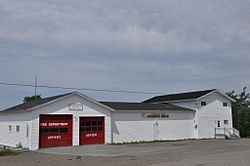History
The name Birchy Bay is derived from the many birch trees which were found on its shores many years ago. Birchy Bay was first home to the native people of the Island which would have used the river which flows through the community as a source of fresh water and also to procure salmon and trout.
Tradition shows that there was a European fisherman shot at but not killed by a Beothuk man who used a decoy to lure the man within shot. The local lookout as known today was also recorded to have been used by the Beothuk and a large pine tree which grew at its summit was relieved of all its bark from the natives climbing to watch over the surrounding land.
The first recorded family to come and stay in Birchy Bay was Andrew Canning Sr. a man with unknown origins but came from Barr'd Islands to salmon fish. The family lived on the tilt and latter returned to Fogo Island when his sons died he returned to Barr'd Island. The grandson of Andrew Sr., John Canning returned to Birchy Bay with his wife in 1886 along came his adoptive sister Amelia Diamond Mews and James Mews. They began to farm in the community after the agriculture act of 1886. Soon after families such as the Quinlans, Osmond's and Popes came to settle in Birchy Bay. Birchy bays chief income was the logging industry in the early 1900s the French family of Summerford opened a steam-powered sawmill procuring lumber from the country and driving it down the streams and brooks. Also the lobster fishery along with trapping was another means of income in the early days.
This page is based on this
Wikipedia article Text is available under the
CC BY-SA 4.0 license; additional terms may apply.
Images, videos and audio are available under their respective licenses.

